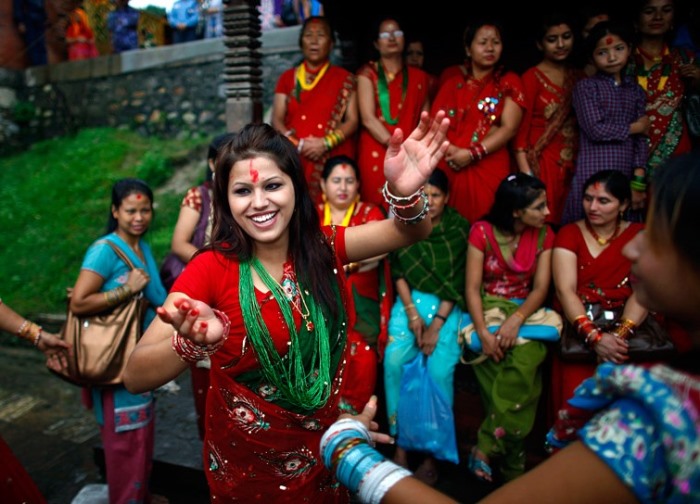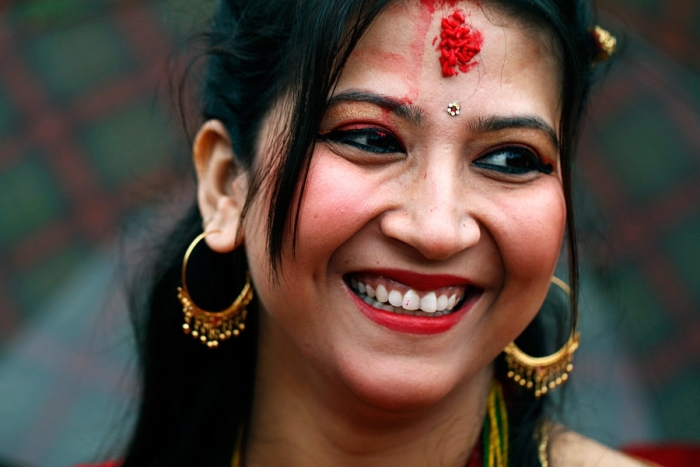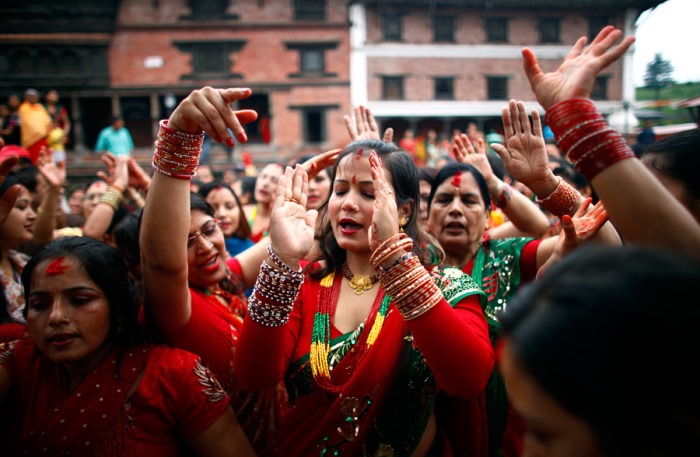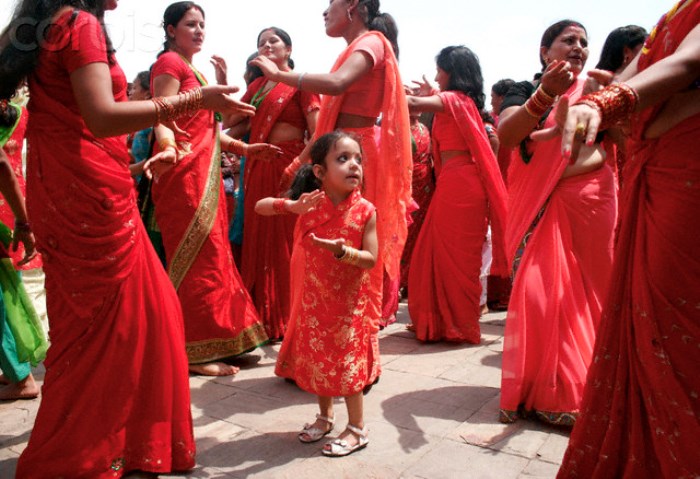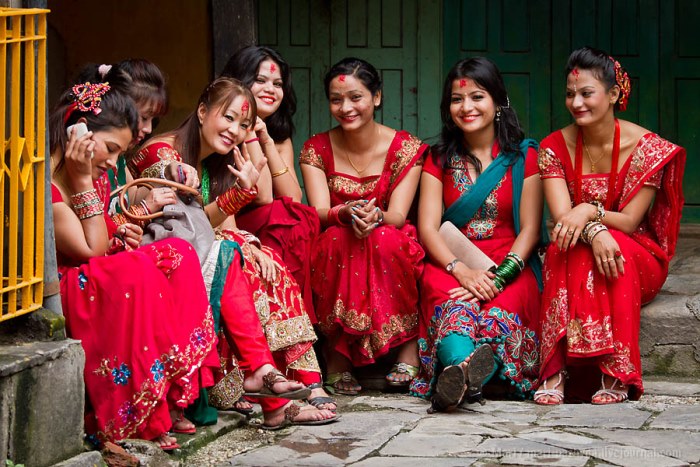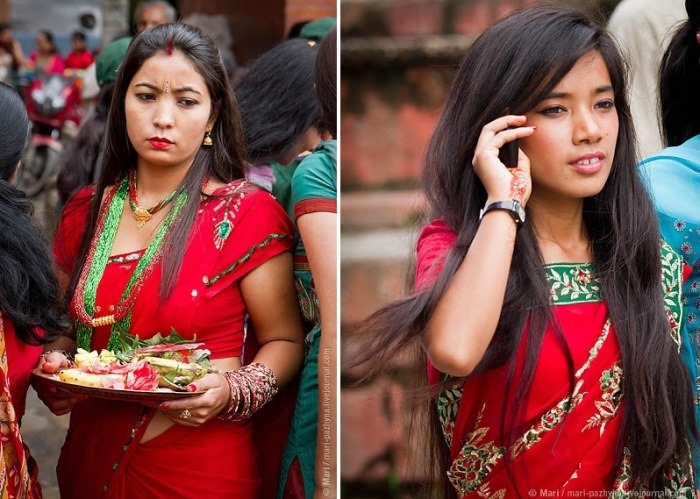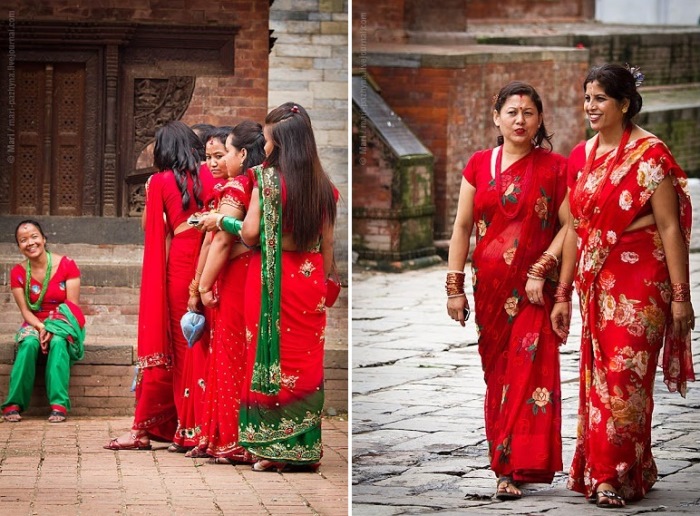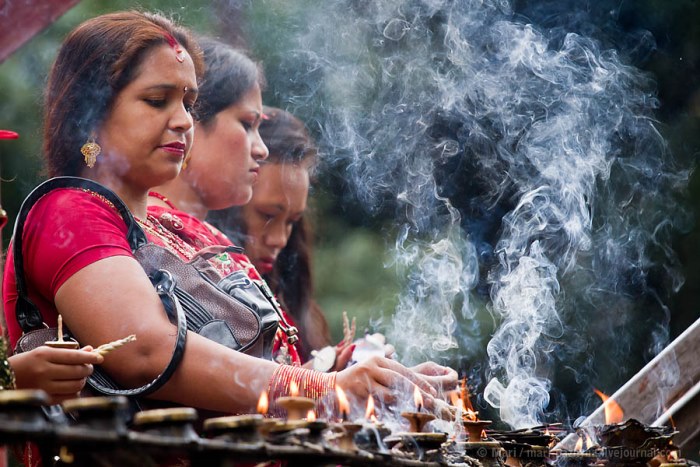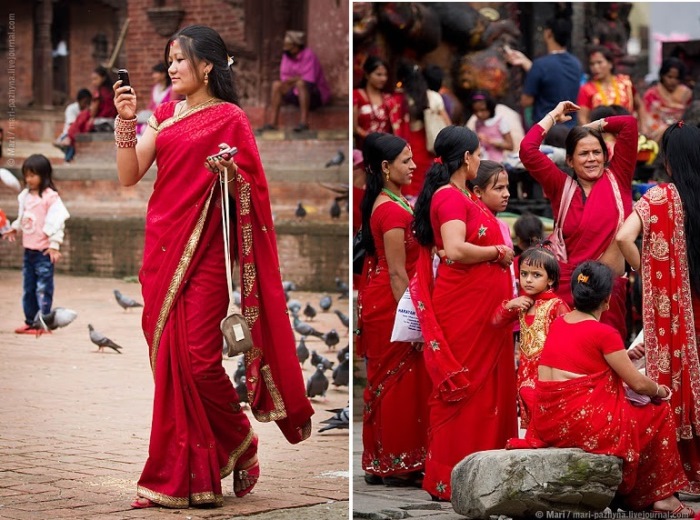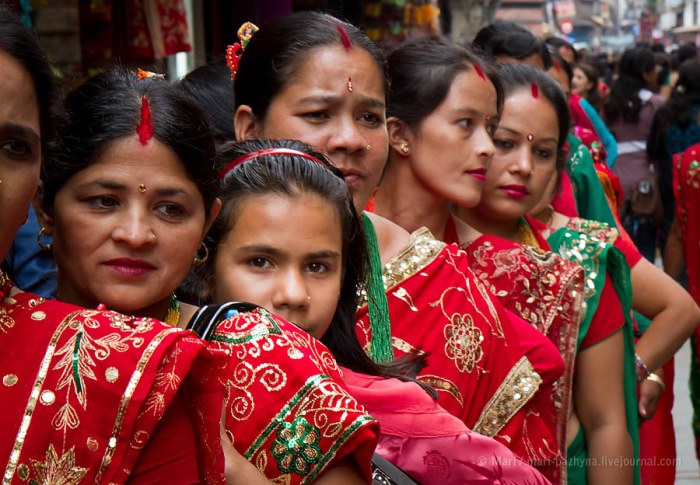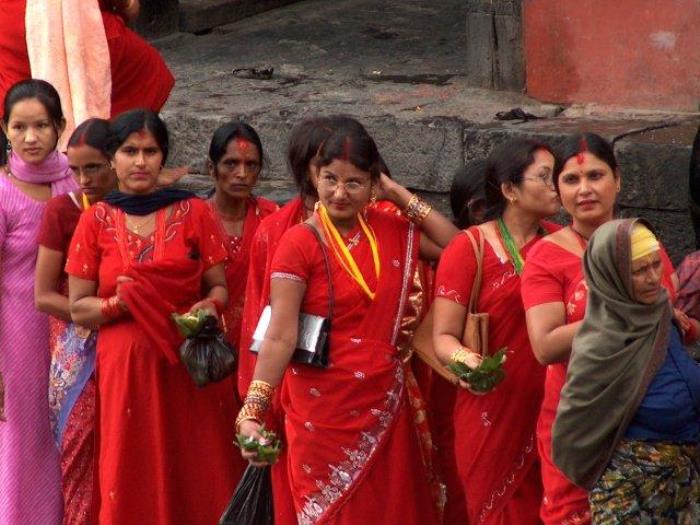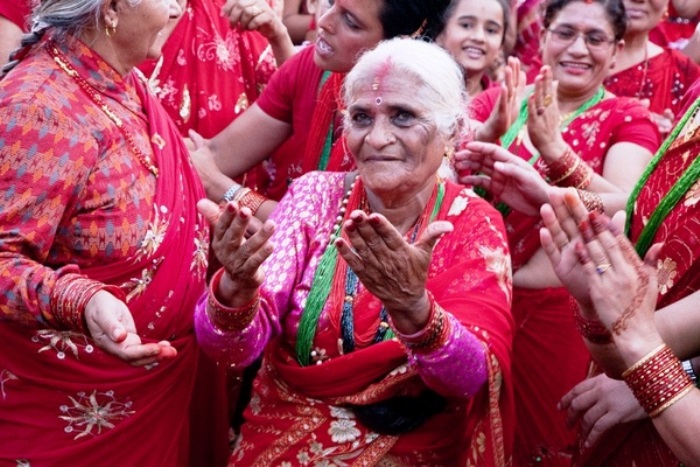This article is about the festival. For the mite, see Trombidiidae.
|
|
|---|---|
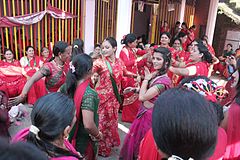
Women celebrating Haritalika Teej in Nepal |
|
| Observed by | Hindu women |
| Liturgical color | Red |
| Type | Hindu |
| Significance | Signifies the penance made by goddess Parvati to receive lord Shiva as her husband |
| Celebrations | Fasting, worshipping lord Shiva, gathering, dancing, singing |
| Date | July–September |
| Frequency | Annual |
Teej (Nepali: तीज, romanized: Tīja) is the generic name for a number of Hindu festivals that are celebrated by women and girls. Haryali Teej and Hartalika Teej welcome the monsoon season and are celebrated primarily by girls and women, with singing, dancing, enjoyment and prayer rituals. The monsoon festivals of Teej are primarily dedicated to Parvati and her reunion with Lord Shiva.[1] Women often fast in celebration of Teej.
Hartalika Teej is celebrated in hilly and terai regions of Nepal and most of the parts of North India (Bihar, Uttar Pradesh, Madhya Pradesh, Uttarakhand, and Rajasthan). Teej festivals are traditionally observed by women to celebrate the monsoons during the months of Shravan and Bhadrapada of Hindu calendar. Women pray to Parvati and Shiva during Teej.
Etymology[edit]
Red velvet mite (Trombidium), also called Teej, appears during the monsoon season.[2] It is unclear if the mite is named after the festival, or vice versa.
Teej refers to the third day that falls every month after the new moon (amavasya), and the third day after the full moon night of every lunar month.[3] According to Kumar (1988), Kajari Teej and Hartalika Teej fall in Bhadrapada.[4]
Teej refers to the monsoon festivals, observed particularly in western and northern states of India and Nepal. The festivals celebrate the bounty of nature, arrival of clouds and rain, greenery and birds with social activity, rituals and customs.[5] The festivals for women, include dancing, singing, getting together with friends and telling stories, dressing up with henna-coloured hands and feet, wearing red, green or orange clothes, sharing festive foods,[5] and playing under trees on swings on Haryali Teej.[6] The monsoon festival in Rajasthan is dedicated to Parvati.[5]
Types of Teej[edit]
Teej festivals are traditionally observed by women to celebrate the monsoons during the months of Shravan[7][8] and Bhadrapada in the Hindu calendar. Women often pray to Parvati and Shiva during Teej.[7][9][10]
Haryali Teej[edit]
Haryali Teej (lit. Green Teej) is celebrated on the third day after the new moon in the month of Shraavana/Sawan (of the Hindu calendar).[11] As Shraavana falls during the monsoon or rainy season when the surroundings become green, the Shraavana Teej is also called Hariyali Teej.
The Hariyali Teej festival is also celebrated to remember the reunion of Shiva and Parvati, the day when Shiva accepted Parvati as his wife. Parvati fasted and was austere for many years and was accepted by Shiva as his wife in her 108 birth. Parvati is also known as Teej mata (lit. Teej mother).[12]
Sindhara[edit]
On Teej married daughters receive the gifts by her mother such clothes, bangles, bindi, mehandi, etc. Ghevar, a special sweet, are given to them on this day. These gifts are known as Sindhara. According to Bhatnager (1988), Sindhara is derived from the Sanskrit word «Sringar» which means ‘decoration of women and their charming beauty’. These gifts include sweets, henna, new bangles, and a new dress. The rich send expensive gifts. The unmarried girls also receive new clothes and articles of decoration.[13]
Observance of Haryali Teej[edit]
Haryali teej is celebrated in Punjab, Haryana and Rajasthan.[14] The festival is also celebrated in Chandigarh.[15]
Chandigarh[edit]
Chandigarh administration makes special arrangements for Teej celebration in the Rock Garden in the city. School children present plays and other cultural programs on this day. The female members of the family, especially daughters, are given gifts and dresses.[16][additional citation(s) needed]
Haryana[edit]
Haryali Teej is one of the famous festivals of Haryana, and is celebrated as an official holiday. Many functions are organised by the Government of Haryana to celebrate this festival, which welcomes the rainy season. Boys traditionally flew kites from morning to evening, though this tradition is losing its charm in big cities due to high rise buildings and lack of terrace space.[citation needed]
Swings are set up in open courtyards, under trees for the season. Girls apply henna to their hands and feet and are excused from household chores on this day. On Teej, girls often receive new clothes from their parents.[citation needed]
On Teej, just as on Karva Chauth, the mother sends a baya or gift. The puja is performed in the morning. The baya, which consists of a variety of foodstuffs, is placed on a thaali at a place of worship where a chowk (square) has been decorated, and an idol or picture of Parvati has been installed. The evenings are set aside for folk singing and dancing, including the women’s prayers for their husbands’ longevity and their families.[citation needed]
Punjab[edit]
Teej is known as Teeyan in Punjab and is seen as a seasonal festival which is dedicated to the onset of the monsoon.[17][11] The festival is celebrated by women of all faiths, and lasts from the third day of the bright half of the lunar month of Sawan as per the Bikrami calendar (Punjabi calendar) to the full moon of Sawan (about 13 days). Teeyan involves women getting together and performing Gidda, married women visiting their families and receiving gifts. It is also traditional for women to ride on swings.
Fairs are organised in schools and colleges where dance competitions are held.[18][19]
Teeyan is a festival when girls play on swings that are set up under trees or open courtyards. During Teeyan, family members give gifts, typically new clothes and accessories, to girls and women. Sweets are prepared especially ghevar in some parts of Punjab.[11]
Rajasthan[edit]
Teej welcomes the monsoon and observed in the month of Shravan (July/August). The monsoon rains fall on the parched land and the pleasing scent of the wet soil rises into the air. Swings are hung from trees and women dressed in green clothes sing songs in celebration of the advent of the monsoon.[5]
This festival is dedicated to Parvati, commemorating her union with Shiva.[5] Parvati is worshipped by seekers of conjugal bliss and happiness. An elaborate procession is taken out in Jaipur for two continuous days on the festive occasion which is watched by people in large numbers.[citation needed] The Teej idol is covered with a canopy whereas the Gangaur idol is open. The traditional ghevar sweet is also associated with the festival.
During Teej, Parvati is worshiped. The day before Haryali Teej, is celebrated as Sinjara, wherein women put mehandi on their hands and eat.[citation needed]
Kajari Teej[edit]
Kajari Teej is celebrated in the Bikrami lunar month of Bhadrapud: the third day of the dark fortnight of Bhadrapada.[20] Kajari Teej is also called Boorhi Teej.[21][additional citation(s) needed] In Rajasthan, Kajari Teej is called Badi Teej (lit. Bigger Teej)[22][additional citation(s) needed] as it follows Haryali Teej, which is known as Chhoti Teej (lit. Smaller Teej).
Women in Uttar Pradesh pray to Shiva on Kajari Teej.[23][additional citation(s) needed] It is also customary to sing folk songs known as kajris. The focus of the lyrics is usually on separation expressing the pining of a woman for her beloved in her parents’ home, where she has been sent to celebrate Teej,[18][additional citation(s) needed] or waiting in anticipation to be collected by brothers to celebrate Teej.[citation needed] The kajri is a folk song composed and sung in the regions of eastern Uttar Pradesh, Bihar and in parts of Madhya Pradesh and Rajasthan.[24]
Women who observe the Kajari Teej fast go without food and water.[20] Kajari Teej is associated closely with Kajali Teej, which also involves praying to the moon. The fast is broken by eating sattu.[22][self-published source?] The other focus of the day is to pray to the neem tree. A fair is held in Bundi in Rajasthan to celebrate Kajari Teej.[23][page needed][additional citation(s) needed]
Hartalika Teej[edit]
Hartalika is a combination of the Sanskrit words harit and aalika which means «abduction» and «female friend» respectively. According to the legend of Hartalika Teej, Parvati, incarnated as Shailaputri[25][26]
On the third day of the bright half of Bhadrapud, Parvati made a shiva lingam out of sand and silt of Ganga and prayed. Shiva was so impressed that he gave his word to marry Parvati. Eventually, Parvati was united with Shiva and was married to him with her father’s blessing. Since then, the day is referred to as Hartalika Teej as Parvati’s female (aalika) friend had to abduct (harit) her in order for the goddess to achieve her goal of marrying Shiva.[citation needed]
Accordingly, Hartalika Teej is seen as a major festival and is celebrated on the third day of the bright half of the Indian/North Nepali Lunar month of Bhadrapud. The festival women feasting during the evening of Hartalika Teej, praying to Parvati and Shiva, remembering their wedding and staying up all night listening to prayers.[27][additional citation(s) needed] The fast (also called nishivasar nirjala vrat) commences during the evening of Hartalika Teej and is broken the next day after a full day’s observance which involves women not even drinking water.[citation needed] The focus is on praying to Parvati[28][page needed] whom Shiva desired should be worshipped under the name Hartalika.[citation needed] [29] The main areas of celebration are Bihar, Rajasthan, Uttar Pradesh and Uttarakhand,. In Rajasthan, an idol of Parvati is taken out in procession in the streets accompanied by singing, and music. Hartalika Teej has also spread to parts of Madhya Pradesh, Chhattisgarh .[citation needed]
In Maharashtra Hartalika teej also known as Hartalika tritiya vrat, which is celebrated in similar manner like northern India. It is observed by married women for the welfare, health, and long life of their husbands and for a happy married life and unmarried girls for being blessed with a good husband. It is Nirjala Vrat, they fast for one and half day.
Women do Sola shrungar, apply mehendi, wear new red or green sari observe fast, make idol of shiva, gauri, sakhi and ganesh with clay or river sand, read katha.
They do bhajan sangeet pooja in night as well and open vrat on the second day.
It is very auspicious vrat for women in India to worship goddess Parvati in the form of Gouri along with shiva parivar.
Elsewhere in India[edit]
Akha Teej[edit]
Akha Teej (also called Akshaya Tritiya) falls on the third day after full moon in the month of Vaisakha.[30] It is an auspicious day of the birthday of Parasurama, the sixth incarnation of Vishnu. On this day Veda Vyas and Ganesha began to write the Mahabharata. Jains celebrate this day to commemorate Tirthankara Rishabha’s ending of his fast by consuming sugarcane juice poured into his cupped hands. According to Gagne (2013), Akha Teej is an important festival in the Hindu calendar.[31]
Awra Teej of Madhya Pradesh and Chhattisgarh[edit]
Awra Teej is celebrated in the month of Vaisakh in parts of Madhya Pradesh and Chhattisgarh. This festival of Teej falls in Spring. The month of Vaisakh occurs during spring.[32]
Jhulan Utsav[edit]
Haryali Teej coincides with the swing festival of Jhulan Leela also known as Jhulan Utsav or Hindola Utsav[33] which is associated with Krishna and Radha, and is celebrated at Banke Bihari Temple and other temples in the Vrindavan area of Uttar Pradesh. The festival lasts until Krishna Janmashtami for 13 days.[citation needed]
On the day of Teej, idols of Krishna and Radha are placed on swings in the temples and the focus of Jhulan Leela is religious. The green theme, popular in neighbouring Rajasthan and Haryana on Haryali Teej, can also be seen in the Jhulan Utsav. Idols of Krishna and Radha are dressed in green clothes.
Haryali Teej and Jhulan Utsav fall on the same day, but the Teej is a monsoon festival dedicated to Parvati whereas, Jhulan Utsav is dedicated to Krishna and Radha.
Kajal Teej of Telangana[edit]
Teej in Telangana forms part of a wider celebration which is a forerunner to other festivals being celebrated and is known as Kajal Teej. Kajal Teej is one of the Banjara tribe’s biggest festivals.[8]
Kevada Teej of Gujarat[edit]
Kevada Teej, also known as Kevda Trij, is a festival observed mainly in Gujarat. The festival is celebrated on the third day of the Shukla Paksha (waxing of the moon) of Bhadra in Gujarat. This observance is similar to the Hartalika Teej fast (vrat). Married and unmarried women observe a fast on the day and offer the kevada flower (pine screw) to Parvati and Shiva.[citation needed]
Observance Haritalika Teej in Nepal[edit]
Dedicated to Parvati, commemorating her union with Shiva, the festival is celebrated for well-being of spouse and children and purification of one’s body and soul. The festival is a three-day-long celebration that combines sumptuous feasts as well as rigid fasting. Teej (also romanised Tij) is celebrated by women, for the long life of her husband and long and firm relationship between them in this life and all the lives to come. It is particularly celebrated by women from various castes of Nepalese society, particularly the Bahun, Chettri, Kiratis and others, on the third day after the new moon of the month of Bhadra (mid-August to mid-September).[34][page needed][35][page needed]
Amongst some communities it is viewed as a «festival of sisterhood»,[36] Teej has traditional and modern values as a festival of celebrating good times with siblings. Although it looks like it is celebration of sisterhood because when married women get rare chance to meet with sisters and friends from their birthplace, there is a strong role of brothers to celebrate the festival as they are to call their sisters in this auspicious occasion and cook special food for their sisters, and all the girls enjoy time doing make up to look the best and dance to forget the pain they get from their in-laws, which is expressed in the form of folk songs with particular rhythm.[37]
Traditional values[edit]
According to Hindu mythology, Shree Swosthani Bratakatha, goddess Parvati ran away from her home with her friends to jungle as she was afraid that her father Himalaya promised to Vishnu to give his daughter Parvati in marriage. She then went to jungle and started praying Shiva to fulfill her wish to marry him. He said «tathastu» meaning he will fulfill her wish. That was the day of Teej when Parvati got her husband as her undying wish. So this day is celebrated to get the husband of their dream by unmarried women and for long, healthy and prosperous life of husband by married women.[citation needed]
First day[edit]
The first day of Teej is called Dar Khane Din. On this day the women assemble at one place in their finest attire and start dancing and singing devotional songs. Amidst all this, the grand feast takes place. What is unusual about this day is that the feast is hosted by men. Women, who work hard throughout the year, do not have to do anything that day. That is the day for them to embellish themselves in sorha singaar — dressing up and using make up to the full extent, indulge in good food, and dance. Oftentimes, because women are invited by multiple brothers for the feast, they try to dance off some food before they are ready to eat more. The food served is supposed to be rich and abundant.[citation needed]
This is probably the only day in a year that allows women full freedom of expression. Consequently, women have traditionally used this occasion to express their pains and pang in the songs they sing while dancing. With the advancement of communication and awareness, women these days use this occasion to voice their concerns about social issues and discrimination against women. The jollity often goes on until midnight, after which the 24-hour fast starts.[citation needed]
Second day[edit]
The second day is the day of fasting. Some women don’t eat or drink food and water while others drink liquids and eat fruit. The fasting is observed by married and unmarried women. Married women abstain strictly from food and drinks with a belief that their devotion to the gods will be blessed with longevity, peace and prosperity of their husband and family. Unmarried women observe the fast with a hope of being blessed with a good husband.[38][39]
They dress gaily and visit a nearby Shiva temple singing and dancing on the way. The Pashupatinath Temple gets the highest number of devotees. At the temple, women circumambulate the shiva lingam, which symbolizes Shiva. The main pooja (religious ceremony) takes place with offerings of flowers, fruits, etc., made to Shiva and his wife Parvati, beseeching them to grant their blessing upon the husband and family. The important part of the puja is the oil lamp which should be alight throughout the night. It is believed that by the light of an oil lamp all night will bring peace and prosperity to the husband and family.[40]
Third day[edit]
The third day of the festival is Rishi Panchami.[41] After the completion of the previous day’s puja, women pay homage to seven saints or sages, offer prayers to deities, and bathe with red mud found on the roots of the sacred datiwan bush, along with its leaves. The Rishi Panchami revolves around the purity of women. It is a time when women cleanse themselves of the possible «sin of touching a man during menstruation.»[35][page needed] During this festival, which occurs two days after the Teej, the women participate in ritual baths and puja (worship). One of the defining characteristics of the Teej Festival is the songs the women sing.[42] Traditionally, these songs emphasized the subservient role of women in Nepalese society in addition to reinforcing traditional Hindu ideology of gender relations. Within the past few decades, as Nepal and the surrounding area experiences rapid development and modernization, the Teej songs have become more of a critical commentary on gender relations from women’s perspectives. These songs «extend the women’s thoughts and experiences of hardships from an intimate conversation to a public setting».[43] The Teej songs allow women to effect change in their respective societies by giving them a public voice.[44]
References[edit]
- ^ «[MITCH EPSTEIN]». Aperture (105): 52–57. 1986. JSTOR 24472056.
- ^ J Mohapatra (December 2013). Wellness In Indian Festivals & Rituals. p. 125. ISBN 978-1-4828-1690-7.
- ^ Mahershi, Narendra (2007). Folk music of North Gujarat — a critical evaluation [especially in the reference of ethnomusicology] (Thesis). hdl:10603/58705. ProQuest 1752400726.
- ^ «The Artisans’ World of Music». The Artisans of Banaras. 2017. pp. 125–164. doi:10.1515/9781400886999-012. ISBN 978-1-4008-8699-9.
- ^ a b c d e Bhatnagar, Manju (1988). «The Monsoon Festival Teej in Rajasthan». Asian Folklore Studies. 47 (1): 63–72. doi:10.2307/1178252. JSTOR 1178252.
- ^ Sharma, B. K.; Kulshreshtha, Seema; Rahmani, Asad R. (2013). Faunal Heritage of Rajasthan, India: General Background and Ecology of Vertebrates. Springer Science & Business Media. p. 28. ISBN 978-1-4614-0800-0.
- ^ a b Bandyopadhyay, Sumana; Magsi, Habibullah; Sen, Sucharita; Dentinho, Tomaz Ponce (29 January 2020). Water Management in South Asia: Socio-economic, Infrastructural, Environmental and Institutional Aspects. Springer. p. 224. ISBN 978-3-030-35237-0.
- ^ a b Deogaonkar, Shashishekhar Gopal; Deogaonkar, Shailaja Shashishekhar (1992). The Banjara. Concept Publishing Company. p. 40. ISBN 978-81-7022-433-4.
- ^ Mathur, Barkha (23 August 2013). «Rajasthani women celebrate sinjara on eve of badi teej». The Times of India. Retrieved 29 August 2020.
- ^ Mathur, Barkha (23 August 2013). «Marwari community celebrates Badi Teej the traditional way». The Times of India. Retrieved 29 August 2020.
- ^ a b c Alop Ho Raha Punjabi Virsa: Harkesh Singh KehalUnistar Books PVT Ltd ISBN 81-7142-869-X
- ^ Art Culture and Heritage of Rajasthan Study Material With MCQ: Useful for RPSC RAS Prelims and Other Exams. (n.d.). (n.p.): New Era Publication.
- ^ Bhatnagar, Manju (1988). «The Monsoon Festival Teej in Rajasthan». Asian Folklore Studies. 47 (1): 63–72. doi:10.2307/1178252. JSTOR 1178252.
- ^ Munjal, Parul G (10 August 2015). «The potential of a participatory approach in sustaining the fairs and festivals of small towns: The case of Sohna, Haryana». Worldwide Hospitality and Tourism Themes. 7 (4): 347–366. doi:10.1108/WHATT-03-2015-0008.
- ^ Sinha, Manya; Sachdeva, Palak (7 July 2017). «Teej celebrations begin in Chandigarh». The Times of India. TNN. ProQuest 1916831873.
- ^ Sharma, Poonam (13 August 2010). «Traditional Teej at Rock Garden». The Times of India. Retrieved 29 August 2020.
- ^ Good Earth Punjab Travel Guide. Eicher Goodearth Limited. 2006. p. 188. ISBN 978-81-87780-34-2.
- ^ a b Tribune News Service (26 July 2014). «Mohali school celebrates Teej». The Tribune.
- ^ Women in punjab celebrate ‘teej’. (2010, Aug 1). Asian News International ProQuest 734560315
- ^ a b «What is Kajari Teej?». The Times of India. 12 August 2014. Retrieved 29 August 2020.
- ^ Folk-lore. Volume 14. Indian Publications. 1973. p. 253.
{{cite book}}: CS1 maint: others (link) - ^ a b Rajasthan District Gazetteers: Bikaner. Government Central Press. 1972. p. 117.
- ^ a b Uttar Pradesh District Gazetteers: Kanpur. Government of Uttar Pradesh. 1989. p. 61.
- ^ Jain, Jasbir (2006) Narrative of the village: centre of the periphery
- ^ Jha, O. P. (26 February 2014). Goddess Durga: Gods And Goddesses in India. Diamond Pocket Books Pvt Ltd. ISBN 978-93-5083-441-1.
- ^ Dahal, Kamala (25 December 2020). «Celebrating Teej as a Festival of (Re) union and Enjoyment». Molung Educational Frontier: 29–41. doi:10.3126/mef.v10i1.34027. S2CID 234410894.
- ^ Rāmacandrana, Śivānī (2014). Bhāratīya jayantiyām̐ evaṃ tyohāra. Dillī: Śrīkr̥shṇā Pustaka Bhaṇḍāra. ISBN 978-81-88514-44-1. OCLC 851268802.[page needed]
- ^ Maharashtra State Gazetteers: Buldhana. Director of Government Printing, Stationery and Publications. 1976.
- ^ Pimputkar, S. (2017, Aug 23). Hartalika teej 2017: Significance, legend, rituals, tithi. Free Press Journal ProQuest 2290557959
- ^ Gopal, Madan (1990). K.S. Gautam (ed.). India Through the Ages. Government of India. p. 65. OCLC 1157118397.
- ^ Gagné, Karine (August 2013). «Gone with the Trees: Deciphering the Thar Desert’s Recurring Droughts». Current Anthropology. 54 (4): 497–509. doi:10.1086/671074. S2CID 143967758.
- ^ Gold, D. (2015). Provincial Hinduism: Religion and Community in Gwalior City. United Kingdom: Oxford University Press.
- ^ Press Trust of India (16 August 2015). «Vrindaban gears up for colorful Hindola festival». Business Standard. Retrieved 29 August 2020.
- ^ Skinner, Debra; Holland, Dorothy; Adhikari, G. B. (1994). «The Songs of Tij: A Genre of Critical Commentary for Women in Nepal». Asian Folklore Studies. 53 (2): 259. doi:10.2307/1178647. JSTOR 1178647.
- ^ a b Levy, Robert Isaac; Rājopādhyāya, Kedar Rāj (1990). Mesocosm: Hinduism and the Organization of a Traditional Newar City in Nepal. Berkeley, California: University of California Press. ISBN 0-585-13103-1. OCLC 43476658.
- ^ Basnyat, Aarti (8 September 2005). «Not a tease anymore». Nepali Times. Retrieved 29 August 2020.
- ^ «Original hamkailo teej melody». YouTube.
{{cite web}}: CS1 maint: url-status (link) - ^ Majupuria, Trilok Chandra (1981). Nepal, The Land of Festivals: Religious, Cultural, Social and Historical Festivals). S. Chand. pp. 92–93. ISBN 9780940500839. OCLC 310635107.
- ^ Diwas, Dhakal (2000). Nepalese Culture, Society, and Tourism. M. Dhakal. p. 191. OCLC 604735909.
- ^ Hugh, Finlay (2001). Nepal. Lonely Planet Publications. p. 98. OCLC 320635037.
- ^ Gurung, Bishnu Prasad (2008). Festival & Fetes in Nepal. Monterosa Treks and Expedition. p. 49. ISBN 978-99933-877-0-1. OCLC 457045938.
- ^ Bimala, Shrestha (1997). Social life in Nepal, 1885-1950. Vani Prakashan Co-operative Limited. pp. 126–127. OCLC 1126012625.
- ^ Skinner, Debra; Pach, Alfred; Holland, Dorothy; Holland, Dorothy C. (1998). Selves in Time and Place: Identities, Experience, and History in Nepal. Rowman & Littlefield. p. 98. ISBN 978-0-8476-8599-8.
- ^ Skinner, Debra; Holland, Dorothy; Adhikari, G. B. (1994). «The Songs of Tij: A Genre of Critical Commentary for Women in Nepal». Asian Folklore Studies. 53 (2): 259–305. doi:10.2307/1178647. ISSN 0385-2342. JSTOR 1178647.
Sources[edit]
Wikimedia Commons has media related to Teej.
- Bhatnagar, Manju (1988). «The Monsoon Festival Teej in Rajasthan». Asian Folklore Studies. 47 (1): 63–72. doi:10.2307/1178252. JSTOR 1178252.
- Levy, Robert Isaac; Rājopādhyāya, Kedar Rāj (1990). Mesocosm: Hinduism and the Organization of a Traditional Newar City in Nepal. Berkeley, California: University of California Press. ISBN 0-585-13103-1. OCLC 43476658.
- Skinner, Debra; Holland, Dorothy; Adhikari, G. B. (1994). «The Songs of Tij: A Genre of Critical Commentary for Women in Nepal». Asian Folklore Studies. 53 (2): 259–305. doi:10.2307/1178647. JSTOR 1178647.
This article is about the festival. For the mite, see Trombidiidae.
|
|
|---|---|

Women celebrating Haritalika Teej in Nepal |
|
| Observed by | Hindu women |
| Liturgical color | Red |
| Type | Hindu |
| Significance | Signifies the penance made by goddess Parvati to receive lord Shiva as her husband |
| Celebrations | Fasting, worshipping lord Shiva, gathering, dancing, singing |
| Date | July–September |
| Frequency | Annual |
Teej (Nepali: तीज, romanized: Tīja) is the generic name for a number of Hindu festivals that are celebrated by women and girls. Haryali Teej and Hartalika Teej welcome the monsoon season and are celebrated primarily by girls and women, with singing, dancing, enjoyment and prayer rituals. The monsoon festivals of Teej are primarily dedicated to Parvati and her reunion with Lord Shiva.[1] Women often fast in celebration of Teej.
Hartalika Teej is celebrated in hilly and terai regions of Nepal and most of the parts of North India (Bihar, Uttar Pradesh, Madhya Pradesh, Uttarakhand, and Rajasthan). Teej festivals are traditionally observed by women to celebrate the monsoons during the months of Shravan and Bhadrapada of Hindu calendar. Women pray to Parvati and Shiva during Teej.
Etymology[edit]
Red velvet mite (Trombidium), also called Teej, appears during the monsoon season.[2] It is unclear if the mite is named after the festival, or vice versa.
Teej refers to the third day that falls every month after the new moon (amavasya), and the third day after the full moon night of every lunar month.[3] According to Kumar (1988), Kajari Teej and Hartalika Teej fall in Bhadrapada.[4]
Teej refers to the monsoon festivals, observed particularly in western and northern states of India and Nepal. The festivals celebrate the bounty of nature, arrival of clouds and rain, greenery and birds with social activity, rituals and customs.[5] The festivals for women, include dancing, singing, getting together with friends and telling stories, dressing up with henna-coloured hands and feet, wearing red, green or orange clothes, sharing festive foods,[5] and playing under trees on swings on Haryali Teej.[6] The monsoon festival in Rajasthan is dedicated to Parvati.[5]
Types of Teej[edit]
Teej festivals are traditionally observed by women to celebrate the monsoons during the months of Shravan[7][8] and Bhadrapada in the Hindu calendar. Women often pray to Parvati and Shiva during Teej.[7][9][10]
Haryali Teej[edit]
Haryali Teej (lit. Green Teej) is celebrated on the third day after the new moon in the month of Shraavana/Sawan (of the Hindu calendar).[11] As Shraavana falls during the monsoon or rainy season when the surroundings become green, the Shraavana Teej is also called Hariyali Teej.
The Hariyali Teej festival is also celebrated to remember the reunion of Shiva and Parvati, the day when Shiva accepted Parvati as his wife. Parvati fasted and was austere for many years and was accepted by Shiva as his wife in her 108 birth. Parvati is also known as Teej mata (lit. Teej mother).[12]
Sindhara[edit]
On Teej married daughters receive the gifts by her mother such clothes, bangles, bindi, mehandi, etc. Ghevar, a special sweet, are given to them on this day. These gifts are known as Sindhara. According to Bhatnager (1988), Sindhara is derived from the Sanskrit word «Sringar» which means ‘decoration of women and their charming beauty’. These gifts include sweets, henna, new bangles, and a new dress. The rich send expensive gifts. The unmarried girls also receive new clothes and articles of decoration.[13]
Observance of Haryali Teej[edit]
Haryali teej is celebrated in Punjab, Haryana and Rajasthan.[14] The festival is also celebrated in Chandigarh.[15]
Chandigarh[edit]
Chandigarh administration makes special arrangements for Teej celebration in the Rock Garden in the city. School children present plays and other cultural programs on this day. The female members of the family, especially daughters, are given gifts and dresses.[16][additional citation(s) needed]
Haryana[edit]
Haryali Teej is one of the famous festivals of Haryana, and is celebrated as an official holiday. Many functions are organised by the Government of Haryana to celebrate this festival, which welcomes the rainy season. Boys traditionally flew kites from morning to evening, though this tradition is losing its charm in big cities due to high rise buildings and lack of terrace space.[citation needed]
Swings are set up in open courtyards, under trees for the season. Girls apply henna to their hands and feet and are excused from household chores on this day. On Teej, girls often receive new clothes from their parents.[citation needed]
On Teej, just as on Karva Chauth, the mother sends a baya or gift. The puja is performed in the morning. The baya, which consists of a variety of foodstuffs, is placed on a thaali at a place of worship where a chowk (square) has been decorated, and an idol or picture of Parvati has been installed. The evenings are set aside for folk singing and dancing, including the women’s prayers for their husbands’ longevity and their families.[citation needed]
Punjab[edit]
Teej is known as Teeyan in Punjab and is seen as a seasonal festival which is dedicated to the onset of the monsoon.[17][11] The festival is celebrated by women of all faiths, and lasts from the third day of the bright half of the lunar month of Sawan as per the Bikrami calendar (Punjabi calendar) to the full moon of Sawan (about 13 days). Teeyan involves women getting together and performing Gidda, married women visiting their families and receiving gifts. It is also traditional for women to ride on swings.
Fairs are organised in schools and colleges where dance competitions are held.[18][19]
Teeyan is a festival when girls play on swings that are set up under trees or open courtyards. During Teeyan, family members give gifts, typically new clothes and accessories, to girls and women. Sweets are prepared especially ghevar in some parts of Punjab.[11]
Rajasthan[edit]
Teej welcomes the monsoon and observed in the month of Shravan (July/August). The monsoon rains fall on the parched land and the pleasing scent of the wet soil rises into the air. Swings are hung from trees and women dressed in green clothes sing songs in celebration of the advent of the monsoon.[5]
This festival is dedicated to Parvati, commemorating her union with Shiva.[5] Parvati is worshipped by seekers of conjugal bliss and happiness. An elaborate procession is taken out in Jaipur for two continuous days on the festive occasion which is watched by people in large numbers.[citation needed] The Teej idol is covered with a canopy whereas the Gangaur idol is open. The traditional ghevar sweet is also associated with the festival.
During Teej, Parvati is worshiped. The day before Haryali Teej, is celebrated as Sinjara, wherein women put mehandi on their hands and eat.[citation needed]
Kajari Teej[edit]
Kajari Teej is celebrated in the Bikrami lunar month of Bhadrapud: the third day of the dark fortnight of Bhadrapada.[20] Kajari Teej is also called Boorhi Teej.[21][additional citation(s) needed] In Rajasthan, Kajari Teej is called Badi Teej (lit. Bigger Teej)[22][additional citation(s) needed] as it follows Haryali Teej, which is known as Chhoti Teej (lit. Smaller Teej).
Women in Uttar Pradesh pray to Shiva on Kajari Teej.[23][additional citation(s) needed] It is also customary to sing folk songs known as kajris. The focus of the lyrics is usually on separation expressing the pining of a woman for her beloved in her parents’ home, where she has been sent to celebrate Teej,[18][additional citation(s) needed] or waiting in anticipation to be collected by brothers to celebrate Teej.[citation needed] The kajri is a folk song composed and sung in the regions of eastern Uttar Pradesh, Bihar and in parts of Madhya Pradesh and Rajasthan.[24]
Women who observe the Kajari Teej fast go without food and water.[20] Kajari Teej is associated closely with Kajali Teej, which also involves praying to the moon. The fast is broken by eating sattu.[22][self-published source?] The other focus of the day is to pray to the neem tree. A fair is held in Bundi in Rajasthan to celebrate Kajari Teej.[23][page needed][additional citation(s) needed]
Hartalika Teej[edit]
Hartalika is a combination of the Sanskrit words harit and aalika which means «abduction» and «female friend» respectively. According to the legend of Hartalika Teej, Parvati, incarnated as Shailaputri[25][26]
On the third day of the bright half of Bhadrapud, Parvati made a shiva lingam out of sand and silt of Ganga and prayed. Shiva was so impressed that he gave his word to marry Parvati. Eventually, Parvati was united with Shiva and was married to him with her father’s blessing. Since then, the day is referred to as Hartalika Teej as Parvati’s female (aalika) friend had to abduct (harit) her in order for the goddess to achieve her goal of marrying Shiva.[citation needed]
Accordingly, Hartalika Teej is seen as a major festival and is celebrated on the third day of the bright half of the Indian/North Nepali Lunar month of Bhadrapud. The festival women feasting during the evening of Hartalika Teej, praying to Parvati and Shiva, remembering their wedding and staying up all night listening to prayers.[27][additional citation(s) needed] The fast (also called nishivasar nirjala vrat) commences during the evening of Hartalika Teej and is broken the next day after a full day’s observance which involves women not even drinking water.[citation needed] The focus is on praying to Parvati[28][page needed] whom Shiva desired should be worshipped under the name Hartalika.[citation needed] [29] The main areas of celebration are Bihar, Rajasthan, Uttar Pradesh and Uttarakhand,. In Rajasthan, an idol of Parvati is taken out in procession in the streets accompanied by singing, and music. Hartalika Teej has also spread to parts of Madhya Pradesh, Chhattisgarh .[citation needed]
In Maharashtra Hartalika teej also known as Hartalika tritiya vrat, which is celebrated in similar manner like northern India. It is observed by married women for the welfare, health, and long life of their husbands and for a happy married life and unmarried girls for being blessed with a good husband. It is Nirjala Vrat, they fast for one and half day.
Women do Sola shrungar, apply mehendi, wear new red or green sari observe fast, make idol of shiva, gauri, sakhi and ganesh with clay or river sand, read katha.
They do bhajan sangeet pooja in night as well and open vrat on the second day.
It is very auspicious vrat for women in India to worship goddess Parvati in the form of Gouri along with shiva parivar.
Elsewhere in India[edit]
Akha Teej[edit]
Akha Teej (also called Akshaya Tritiya) falls on the third day after full moon in the month of Vaisakha.[30] It is an auspicious day of the birthday of Parasurama, the sixth incarnation of Vishnu. On this day Veda Vyas and Ganesha began to write the Mahabharata. Jains celebrate this day to commemorate Tirthankara Rishabha’s ending of his fast by consuming sugarcane juice poured into his cupped hands. According to Gagne (2013), Akha Teej is an important festival in the Hindu calendar.[31]
Awra Teej of Madhya Pradesh and Chhattisgarh[edit]
Awra Teej is celebrated in the month of Vaisakh in parts of Madhya Pradesh and Chhattisgarh. This festival of Teej falls in Spring. The month of Vaisakh occurs during spring.[32]
Jhulan Utsav[edit]
Haryali Teej coincides with the swing festival of Jhulan Leela also known as Jhulan Utsav or Hindola Utsav[33] which is associated with Krishna and Radha, and is celebrated at Banke Bihari Temple and other temples in the Vrindavan area of Uttar Pradesh. The festival lasts until Krishna Janmashtami for 13 days.[citation needed]
On the day of Teej, idols of Krishna and Radha are placed on swings in the temples and the focus of Jhulan Leela is religious. The green theme, popular in neighbouring Rajasthan and Haryana on Haryali Teej, can also be seen in the Jhulan Utsav. Idols of Krishna and Radha are dressed in green clothes.
Haryali Teej and Jhulan Utsav fall on the same day, but the Teej is a monsoon festival dedicated to Parvati whereas, Jhulan Utsav is dedicated to Krishna and Radha.
Kajal Teej of Telangana[edit]
Teej in Telangana forms part of a wider celebration which is a forerunner to other festivals being celebrated and is known as Kajal Teej. Kajal Teej is one of the Banjara tribe’s biggest festivals.[8]
Kevada Teej of Gujarat[edit]
Kevada Teej, also known as Kevda Trij, is a festival observed mainly in Gujarat. The festival is celebrated on the third day of the Shukla Paksha (waxing of the moon) of Bhadra in Gujarat. This observance is similar to the Hartalika Teej fast (vrat). Married and unmarried women observe a fast on the day and offer the kevada flower (pine screw) to Parvati and Shiva.[citation needed]
Observance Haritalika Teej in Nepal[edit]
Dedicated to Parvati, commemorating her union with Shiva, the festival is celebrated for well-being of spouse and children and purification of one’s body and soul. The festival is a three-day-long celebration that combines sumptuous feasts as well as rigid fasting. Teej (also romanised Tij) is celebrated by women, for the long life of her husband and long and firm relationship between them in this life and all the lives to come. It is particularly celebrated by women from various castes of Nepalese society, particularly the Bahun, Chettri, Kiratis and others, on the third day after the new moon of the month of Bhadra (mid-August to mid-September).[34][page needed][35][page needed]
Amongst some communities it is viewed as a «festival of sisterhood»,[36] Teej has traditional and modern values as a festival of celebrating good times with siblings. Although it looks like it is celebration of sisterhood because when married women get rare chance to meet with sisters and friends from their birthplace, there is a strong role of brothers to celebrate the festival as they are to call their sisters in this auspicious occasion and cook special food for their sisters, and all the girls enjoy time doing make up to look the best and dance to forget the pain they get from their in-laws, which is expressed in the form of folk songs with particular rhythm.[37]
Traditional values[edit]
According to Hindu mythology, Shree Swosthani Bratakatha, goddess Parvati ran away from her home with her friends to jungle as she was afraid that her father Himalaya promised to Vishnu to give his daughter Parvati in marriage. She then went to jungle and started praying Shiva to fulfill her wish to marry him. He said «tathastu» meaning he will fulfill her wish. That was the day of Teej when Parvati got her husband as her undying wish. So this day is celebrated to get the husband of their dream by unmarried women and for long, healthy and prosperous life of husband by married women.[citation needed]
First day[edit]
The first day of Teej is called Dar Khane Din. On this day the women assemble at one place in their finest attire and start dancing and singing devotional songs. Amidst all this, the grand feast takes place. What is unusual about this day is that the feast is hosted by men. Women, who work hard throughout the year, do not have to do anything that day. That is the day for them to embellish themselves in sorha singaar — dressing up and using make up to the full extent, indulge in good food, and dance. Oftentimes, because women are invited by multiple brothers for the feast, they try to dance off some food before they are ready to eat more. The food served is supposed to be rich and abundant.[citation needed]
This is probably the only day in a year that allows women full freedom of expression. Consequently, women have traditionally used this occasion to express their pains and pang in the songs they sing while dancing. With the advancement of communication and awareness, women these days use this occasion to voice their concerns about social issues and discrimination against women. The jollity often goes on until midnight, after which the 24-hour fast starts.[citation needed]
Second day[edit]
The second day is the day of fasting. Some women don’t eat or drink food and water while others drink liquids and eat fruit. The fasting is observed by married and unmarried women. Married women abstain strictly from food and drinks with a belief that their devotion to the gods will be blessed with longevity, peace and prosperity of their husband and family. Unmarried women observe the fast with a hope of being blessed with a good husband.[38][39]
They dress gaily and visit a nearby Shiva temple singing and dancing on the way. The Pashupatinath Temple gets the highest number of devotees. At the temple, women circumambulate the shiva lingam, which symbolizes Shiva. The main pooja (religious ceremony) takes place with offerings of flowers, fruits, etc., made to Shiva and his wife Parvati, beseeching them to grant their blessing upon the husband and family. The important part of the puja is the oil lamp which should be alight throughout the night. It is believed that by the light of an oil lamp all night will bring peace and prosperity to the husband and family.[40]
Third day[edit]
The third day of the festival is Rishi Panchami.[41] After the completion of the previous day’s puja, women pay homage to seven saints or sages, offer prayers to deities, and bathe with red mud found on the roots of the sacred datiwan bush, along with its leaves. The Rishi Panchami revolves around the purity of women. It is a time when women cleanse themselves of the possible «sin of touching a man during menstruation.»[35][page needed] During this festival, which occurs two days after the Teej, the women participate in ritual baths and puja (worship). One of the defining characteristics of the Teej Festival is the songs the women sing.[42] Traditionally, these songs emphasized the subservient role of women in Nepalese society in addition to reinforcing traditional Hindu ideology of gender relations. Within the past few decades, as Nepal and the surrounding area experiences rapid development and modernization, the Teej songs have become more of a critical commentary on gender relations from women’s perspectives. These songs «extend the women’s thoughts and experiences of hardships from an intimate conversation to a public setting».[43] The Teej songs allow women to effect change in their respective societies by giving them a public voice.[44]
References[edit]
- ^ «[MITCH EPSTEIN]». Aperture (105): 52–57. 1986. JSTOR 24472056.
- ^ J Mohapatra (December 2013). Wellness In Indian Festivals & Rituals. p. 125. ISBN 978-1-4828-1690-7.
- ^ Mahershi, Narendra (2007). Folk music of North Gujarat — a critical evaluation [especially in the reference of ethnomusicology] (Thesis). hdl:10603/58705. ProQuest 1752400726.
- ^ «The Artisans’ World of Music». The Artisans of Banaras. 2017. pp. 125–164. doi:10.1515/9781400886999-012. ISBN 978-1-4008-8699-9.
- ^ a b c d e Bhatnagar, Manju (1988). «The Monsoon Festival Teej in Rajasthan». Asian Folklore Studies. 47 (1): 63–72. doi:10.2307/1178252. JSTOR 1178252.
- ^ Sharma, B. K.; Kulshreshtha, Seema; Rahmani, Asad R. (2013). Faunal Heritage of Rajasthan, India: General Background and Ecology of Vertebrates. Springer Science & Business Media. p. 28. ISBN 978-1-4614-0800-0.
- ^ a b Bandyopadhyay, Sumana; Magsi, Habibullah; Sen, Sucharita; Dentinho, Tomaz Ponce (29 January 2020). Water Management in South Asia: Socio-economic, Infrastructural, Environmental and Institutional Aspects. Springer. p. 224. ISBN 978-3-030-35237-0.
- ^ a b Deogaonkar, Shashishekhar Gopal; Deogaonkar, Shailaja Shashishekhar (1992). The Banjara. Concept Publishing Company. p. 40. ISBN 978-81-7022-433-4.
- ^ Mathur, Barkha (23 August 2013). «Rajasthani women celebrate sinjara on eve of badi teej». The Times of India. Retrieved 29 August 2020.
- ^ Mathur, Barkha (23 August 2013). «Marwari community celebrates Badi Teej the traditional way». The Times of India. Retrieved 29 August 2020.
- ^ a b c Alop Ho Raha Punjabi Virsa: Harkesh Singh KehalUnistar Books PVT Ltd ISBN 81-7142-869-X
- ^ Art Culture and Heritage of Rajasthan Study Material With MCQ: Useful for RPSC RAS Prelims and Other Exams. (n.d.). (n.p.): New Era Publication.
- ^ Bhatnagar, Manju (1988). «The Monsoon Festival Teej in Rajasthan». Asian Folklore Studies. 47 (1): 63–72. doi:10.2307/1178252. JSTOR 1178252.
- ^ Munjal, Parul G (10 August 2015). «The potential of a participatory approach in sustaining the fairs and festivals of small towns: The case of Sohna, Haryana». Worldwide Hospitality and Tourism Themes. 7 (4): 347–366. doi:10.1108/WHATT-03-2015-0008.
- ^ Sinha, Manya; Sachdeva, Palak (7 July 2017). «Teej celebrations begin in Chandigarh». The Times of India. TNN. ProQuest 1916831873.
- ^ Sharma, Poonam (13 August 2010). «Traditional Teej at Rock Garden». The Times of India. Retrieved 29 August 2020.
- ^ Good Earth Punjab Travel Guide. Eicher Goodearth Limited. 2006. p. 188. ISBN 978-81-87780-34-2.
- ^ a b Tribune News Service (26 July 2014). «Mohali school celebrates Teej». The Tribune.
- ^ Women in punjab celebrate ‘teej’. (2010, Aug 1). Asian News International ProQuest 734560315
- ^ a b «What is Kajari Teej?». The Times of India. 12 August 2014. Retrieved 29 August 2020.
- ^ Folk-lore. Volume 14. Indian Publications. 1973. p. 253.
{{cite book}}: CS1 maint: others (link) - ^ a b Rajasthan District Gazetteers: Bikaner. Government Central Press. 1972. p. 117.
- ^ a b Uttar Pradesh District Gazetteers: Kanpur. Government of Uttar Pradesh. 1989. p. 61.
- ^ Jain, Jasbir (2006) Narrative of the village: centre of the periphery
- ^ Jha, O. P. (26 February 2014). Goddess Durga: Gods And Goddesses in India. Diamond Pocket Books Pvt Ltd. ISBN 978-93-5083-441-1.
- ^ Dahal, Kamala (25 December 2020). «Celebrating Teej as a Festival of (Re) union and Enjoyment». Molung Educational Frontier: 29–41. doi:10.3126/mef.v10i1.34027. S2CID 234410894.
- ^ Rāmacandrana, Śivānī (2014). Bhāratīya jayantiyām̐ evaṃ tyohāra. Dillī: Śrīkr̥shṇā Pustaka Bhaṇḍāra. ISBN 978-81-88514-44-1. OCLC 851268802.[page needed]
- ^ Maharashtra State Gazetteers: Buldhana. Director of Government Printing, Stationery and Publications. 1976.
- ^ Pimputkar, S. (2017, Aug 23). Hartalika teej 2017: Significance, legend, rituals, tithi. Free Press Journal ProQuest 2290557959
- ^ Gopal, Madan (1990). K.S. Gautam (ed.). India Through the Ages. Government of India. p. 65. OCLC 1157118397.
- ^ Gagné, Karine (August 2013). «Gone with the Trees: Deciphering the Thar Desert’s Recurring Droughts». Current Anthropology. 54 (4): 497–509. doi:10.1086/671074. S2CID 143967758.
- ^ Gold, D. (2015). Provincial Hinduism: Religion and Community in Gwalior City. United Kingdom: Oxford University Press.
- ^ Press Trust of India (16 August 2015). «Vrindaban gears up for colorful Hindola festival». Business Standard. Retrieved 29 August 2020.
- ^ Skinner, Debra; Holland, Dorothy; Adhikari, G. B. (1994). «The Songs of Tij: A Genre of Critical Commentary for Women in Nepal». Asian Folklore Studies. 53 (2): 259. doi:10.2307/1178647. JSTOR 1178647.
- ^ a b Levy, Robert Isaac; Rājopādhyāya, Kedar Rāj (1990). Mesocosm: Hinduism and the Organization of a Traditional Newar City in Nepal. Berkeley, California: University of California Press. ISBN 0-585-13103-1. OCLC 43476658.
- ^ Basnyat, Aarti (8 September 2005). «Not a tease anymore». Nepali Times. Retrieved 29 August 2020.
- ^ «Original hamkailo teej melody». YouTube.
{{cite web}}: CS1 maint: url-status (link) - ^ Majupuria, Trilok Chandra (1981). Nepal, The Land of Festivals: Religious, Cultural, Social and Historical Festivals). S. Chand. pp. 92–93. ISBN 9780940500839. OCLC 310635107.
- ^ Diwas, Dhakal (2000). Nepalese Culture, Society, and Tourism. M. Dhakal. p. 191. OCLC 604735909.
- ^ Hugh, Finlay (2001). Nepal. Lonely Planet Publications. p. 98. OCLC 320635037.
- ^ Gurung, Bishnu Prasad (2008). Festival & Fetes in Nepal. Monterosa Treks and Expedition. p. 49. ISBN 978-99933-877-0-1. OCLC 457045938.
- ^ Bimala, Shrestha (1997). Social life in Nepal, 1885-1950. Vani Prakashan Co-operative Limited. pp. 126–127. OCLC 1126012625.
- ^ Skinner, Debra; Pach, Alfred; Holland, Dorothy; Holland, Dorothy C. (1998). Selves in Time and Place: Identities, Experience, and History in Nepal. Rowman & Littlefield. p. 98. ISBN 978-0-8476-8599-8.
- ^ Skinner, Debra; Holland, Dorothy; Adhikari, G. B. (1994). «The Songs of Tij: A Genre of Critical Commentary for Women in Nepal». Asian Folklore Studies. 53 (2): 259–305. doi:10.2307/1178647. ISSN 0385-2342. JSTOR 1178647.
Sources[edit]
Wikimedia Commons has media related to Teej.
- Bhatnagar, Manju (1988). «The Monsoon Festival Teej in Rajasthan». Asian Folklore Studies. 47 (1): 63–72. doi:10.2307/1178252. JSTOR 1178252.
- Levy, Robert Isaac; Rājopādhyāya, Kedar Rāj (1990). Mesocosm: Hinduism and the Organization of a Traditional Newar City in Nepal. Berkeley, California: University of California Press. ISBN 0-585-13103-1. OCLC 43476658.
- Skinner, Debra; Holland, Dorothy; Adhikari, G. B. (1994). «The Songs of Tij: A Genre of Critical Commentary for Women in Nepal». Asian Folklore Studies. 53 (2): 259–305. doi:10.2307/1178647. JSTOR 1178647.
Фестиваль Тидж (Teej festival). Праздник семейного счастья
Ежегодно в августе-сентябре по всей Индии и в Непале проходят массовые празднования Тидж (Teej), в которых принимают участие только женщины. Праздник посвящен богу Шиве и его жене богине Парвати, чей брак считается идеальным и священным. В Непале в этом году фестиваль проходил с 15 по 17 сентября. В эти дни мужчины работают, а у их жен – выходной! Они надевают красные сари и украшения, наносят на кожу рисунки хной (мехинди), молятся за семейное счастье и здоровье мужей, поют и танцуют. Тидж – один из самых красочных и ярких праздников – далее в фотообзоре.
Самый радостный праздник для женщин
Женщины танцуют и поют на фестивале Тидж
Согласно индуистской мифологии, на третий день после новолуния в августе Парвати воссоединилась с Шивой. А до этого она пережила более ста перевоплощений, ожидая такой возможности. И была вознаграждена за покорность, преданность и терпение. Именно этими качествами и должна обладать жена, по мнению индуистов.
Девочка танцует со своими старшими родственницами
Современные девушки на древнем религиозном празднике
Получив в этот день благословение Шивы и Парвати, можно обрести счастье в семейной жизни. Для этого женщины, исповедующие индуизм, зажигают благовония в храмах и поют песни, прославляющие брак Шивы и Парвати. Со всей долины Катманду женщины приходят с подношениями (в основном, цветами и фруктами) в Пашупатинатх – самый большой в Непале храмовый комплекс, посвященный Шиве. Замужние женщины молятся о здоровье своих мужей и о крепких брачных узах, а незамужние просят у бога послать им хорошего жениха и счастливую семейную жизнь.
Индийские красотки на фестивале Тидж
Женщины в традиционных красных сари
Это один из самых веселых и радостных праздников в году. Женщины надевают свои самые лучшие (как правило, свадебные) сари, расшитые золотыми нитками, и поют и танцуют прямо на улицах города. Первый день полностью посвящен танцам и пиршествам, что символизирует благополучие, изобилие и радость в семье. На второй день женщины постятся, некоторые даже не пьют воду – в память о долготерпении и покорности Парвати. В третий день совершают обряд омовения с лечебными красными грязями с целью избавления от грехов.
Обязательный ритуал во время празднований: женщины зажигают благовония возле храма
Фестиваль Тидж
Кто-то делает селфи, кто-то танцует
В этот период в северной и западной Индии также празднуется приход муссонов после сезона невыносимой жары. «Teej» – это маленькое красное насекомое, которое появляется из почвы во время дождей. Отсюда и название праздника – Тидж.
Женщины в очереди к храму Шивы
Женщины в очереди к храму Шивы
На праздник семейного счастья приходят женщины всех возрастов
Кроме фестиваля семейного счастья, в Непале есть много других интересных традиций и праздников, связанных с религиозными верованиями. Например, почитание кумари — непальских богинь из плоти и крови
Понравилась статья? Тогда поддержи нас, жми:
| Тидж | |
|---|---|
 Женщины празднуют Тидж в Непале Женщины празднуют Тидж в Непале |
|
| Наблюдают | индуистские женщины в Индии и Непале |
| Тип | Фестивали муссонов |
| Дата | июль – сентябрь |
Тидж — общее название ряда индуистских фестивалей, которые отмечаются женщинами во многих частях Индии. (в основном в Северной и Центральной Индии ) и Непале. Харьяли Тидж и Харталика Тидж приветствуют сезон дождей и отмечаются в основном девушками и женщинами песнями, танцами и молитвенными ритуалами. Фестивали сезонных дождей в Тидж в первую очередь посвящены Парвати и ее союзу с Шивой. Женщины часто постятся в честь Тиджа.
Содержание
- 1 Этимология
- 2 Типы Тидж
- 3 Харьяли Тидж
- 3.1 Синдхара Тидж
- 3.2 Соблюдение Харьяли Тидж
- 3.2.1 Регион Пенджаба
- 3.2.1.1 Чандигарх
- 3.2.1.2 Харьяна
- 3.2.1.3 Пенджаб
- 3.2.2 Раджастхан
- 3.2.1 Регион Пенджаба
- 4 Каджари Тидж
- 5 Харталика Тидж
- 6 В другом месте Индии
- 6,1 Акха Тидж
- 6.2 Авра Тидж из Мадхья-Прадеша и Чхаттисгарха
- 6.3 Джулан Утсав
- 6.4 Каджал Тидж из Теланганы
- 6.5 Кевада Тидж из Гуджрата
- 6.6 Тай или Тайи
- 7 Соблюдение в Непале Хариталика
- Тидж 7.1 Традиционные ценности
- 7.2 Первый день
- 7.3 Второй день
- 7.4 Третий день
- 8 Синд
- 9 См. Также
- 10 Ссылки
- 11 Источники
Этимология

Тидж относится к третьему дню, выпадающему каждый месяц после новолуния (амавасья ), и на третий день после полнолуния ночи каждого месяца. Фестивали сезонных дождей в Тидж включают Харьяли Тидж, Каджари Тидж и Харталика Тидж.
Тидж относится к праздникам сезонных дождей, которые отмечаются, в частности, в западных и северных штатах Индии и Непале. Фестивали празднуют щедрость природы, приход облаков и дождя, зелени и птиц с общественной деятельностью, ритуалами и обычаями. Фестивали для женщин включают в себя танцы, пение, встречи с друзьями и рассказывание историй, переодевание руками и ногами цвета хны, красную, зеленую или оранжевую одежду, совместное использование праздничных блюд и игры под деревьями на качелях на Харьяли Тидж.
Фестивали во многих частях Индии и Непала посвящены Парвати.
Типы праздников Тидж
Фестивали Тидж традиционно отмечаются женщинами, чтобы отметить сезон дождей во время сезона дождей. месяцев Шравана и Бхадрапады в индуистском календаре. Женщины часто молятся Парвати и Шиве во время Тидж.
Харьяли Тидж
Харьяли Тидж (букв. Зеленый Тидж) празднуется на третий день после полнолуния в месяце шравана / саван (индуистского календаря ). Поскольку Шравана падает во время сезона дождей или дождей, когда окрестности становятся зелеными, Шравана Тидж также называется Харияли Тидж. Соблюдается пост, и в центре внимания находится луна.
Фестиваль Харияли Тидж также отмечается в память о воссоединении Шивы и Парвати, в день, когда Шива принял Парвати как свою жену. Парвати много лет постилась и была аскетична и была принята Шивой как его жена в ее 108 рождении. Парвати также известна как Тидж мата (букв. Мать Тидж).
Синдхара Тидж
В Синдхара Тидж замужние дочери получают от своей матери такие подарки, как одежду, браслеты, бинди, механди и т. Д. гевар, особая сладость, дарят им в этот день. Эти дары известны как Синдхара.
Соблюдение Харьяли Тидж
Традиционными областями празднования являются: регион Пенджаб и Раджастхан.
регион Пенджаб
Харьяли Тидж — это праздник, когда девушки играют на качелях, установленных под деревьями или открытыми дворами. Во время Teej родственники, мужья и другие члены семьи дарят девушкам и женщинам подарки, как правило, новую одежду и аксессуары. Мальчики запускают воздушных змеев. приготовьте чурму и сладости, особенно гевар у себя дома.
Фестиваль отмечается в Пенджабе, Харьяне и Чандигарх.
Чандигарх
Администрация Чандигарха принимает особые меры для празднования Тидж в Саду камней в городе. В этот день школьники представляют спектакли и другие культурные программы. Члены семьи, особенно дочери, получают подарки и платья.
Харьяна
Харьяли Тидж — один из самых известных фестивалей Харьяны, который отмечается как официальный праздник. Правительство Харьяны организует множество мероприятий, чтобы отпраздновать этот праздник, который приветствует сезон дождей. Мальчики традиционно запускали воздушных змеев с утра до вечера, хотя эта традиция теряет свое очарование в больших городах из-за высотных зданий и отсутствия террасы.
Качели устанавливают в открытых двориках, под деревьями по сезону. Девочки наносят хну на руки и ноги и в этот день освобождаются от домашних дел. На Тидже девочки часто получают новую одежду от своих родителей.
На Тидже, как и на Карва Чаут, мать посылает байю или подарок. Пуджа проводится утром. Байя, состоящая из разнообразных продуктов, помещается на тхали в месте поклонения, где был украшен чоук (квадрат) и идол или изображение Парвати была установлена. Вечера отведены для народного пения и танцев, в том числе женских молитв о долголетии их мужей и их семей.
.
Пенджаб

Тидж известен как Тейян в Пенджаб и рассматривается как сезонный фестиваль, посвященный началу сезона дождей. Фестиваль отмечается женщинами всех вероисповеданий и длится с третьего дня светлой половины лунного месяца Саван по пенджабскому календарю до полнолуния Саван (около 13 дней). Teeyan — это женщины, которые собираются вместе и исполняют Gidda, замужние женщины навещают свои семьи и получают подарки. Катание на качелях также является традиционным для женщин.
Ярмарки организуются в школах и колледжах, где проводятся танцевальные соревнования.
Раджастхан
Тидж приветствует сезон дождей и отмечается в месяце Шраван ( Июль Август). Муссонные дожди падают на иссушенную землю, и приятный аромат влажной почвы поднимается в воздух. Качели подвешены к деревьям, и женщины, одетые в зеленые одежды, поют песни в честь прихода муссонов.
Этот фестиваль посвящен Парвати, ознаменовав ее союз с Шивой. Парвати поклоняются искатели супружеского блаженства и счастья. Сложная процессия проводится в Джайпуре в течение двух дней подряд по празднику, за которым наблюдают в большом количестве люди. Идол Тиджа накрыт навесом, а идол Гангавр открыт. Традиционная сладость гевар также связана с праздником.
Во время Тиджа поклоняются Парвати. За день до Харьяли Тидж отмечается как Синджара, когда женщины кладут механди на руки и едят.
Каджари Тидж

Каджари Тидж празднуется в северноиндийский лунный месяц Бхадрапуд: третий день темных двух недель Бхадрапады. Каджари Тидж также называют Боорхи Тидж. В Раджастхане Каджари Тидж называется Бади Тидж (букв. Большой Тидж), поскольку следует за Харьяли Тидж, которая известна как Чхоти Тидж (букв. Меньший Тидж).
Женщины в Уттар-Прадеш молятся Шиве на Каджари Тидж. Также принято петь народные песни, известные как каджри. В центре внимания лирики обычно находится разлука, выражающая тоску женщины по своему возлюбленному в родительском доме, куда ее отправили праздновать Тидж, или ожидание в ожидании, когда братья заберут ее на празднование Тиджа. Каджри — это народная песня, которую сочиняют и поют в регионах восточной части Уттар-Прадеша, Бихара и в некоторых частях Мадхья-Прадеша и Раджастхана.
Женщины, соблюдающие пост Каджари Тидж, обходятся без еды и воды. Каджари Тидж тесно связан с Каджали Тидж, что также включает в себя молитву луне. Пост нарушается употреблением сатту. Другая цель дня — помолиться дереву ним. Ярмарка проводится в Бунди в Раджастане, чтобы отпраздновать Каджари Тидж.
Харталика Тидж

Харталика представляет собой комбинацию хинди слов харит и аалика, что означает «похищение» и «подруга» соответственно. Согласно легенде о Харталике Тидж, Парвати, воплощенная как Шайлапутри, была дочерью Химавата, который пообещал ей руку замуж за Вишну по предложению Нарада. Услышав это, Парвати рассказала подруге о решении своего отца, после чего друг отвел Парвати в густой лес, чтобы отец не выдал ее замуж за Вишну против ее желания.
На третьем. В день светлой половины Бхадрапуда Парвати сделала шива-лингам из своих волос и помолилась. Шива был так впечатлен, что дал слово жениться на Парвати. В конце концов, Парвати соединилась с Шивой и вышла за него замуж с благословения своего отца. С тех пор этот день называется Харталика Тидж, поскольку подруга Парвати (аалика) должна была похитить (харить) ее, чтобы богиня достигла своей цели — выйти замуж за Шиву.
Соответственно, Харталика Тидж видна как крупный фестиваль и отмечается на третий день яркой половины северно-индийского лунного месяца Бхадрапуд. Фестивальные женщины пируют вечером Харталика Тидж, молятся Парвати и Шиве, вспоминают свою свадьбу и не спят всю ночь, слушая молитвы. Пост (также называемый нишивасар нирджала врат) начинается вечером Харталика Тидж и прерывается на следующий день после соблюдения полного дня, когда женщины даже не пьют воду. Основное внимание уделяется молитве Парвати, которой, по желанию Шивы, следует поклоняться под именем Харталика.
Основные области празднования: Раджастхан, Уттар-Прадеш, Уттаракханд, Бихар и Джаркханд. В Раджастане идол Парвати выносится процессией по улицам в сопровождении пения и музыки. Харталика Тидж также распространился на части Мадхья-Прадеша и Чхаттисгарх.
Харталика Тидж на севере не следует путать с Харталикой Тидж из Махараштры, который связан с фестиваль Гаури Хабба.
в других местах Индии
Акха Тидж
Акха Тидж (также называемый Акшая Трития) выпадает на третий день после полнолуния в месяце [[Вайшакха ]]. Это благоприятный день дня рождения Парашурамы, шестого воплощения Вишну. В этот день Веда Вьяс и Ганеша начали писать Махабхарату. Джайны празднуют этот день в ознаменование завершения поста Тиртханкары Ришабхи, съев сок сахарного тростника, налитый ему в ладони. Аха Тидж наблюдается во многих частях Индийского субконтинента.
Авра Тидж в Мадхья-Прадеш и Чхаттисгарх
Авра Тидж отмечается в месяце Вайсакх в некоторых частях Мадхья-Прадеш и Чхаттисгарх. Это не связано с трио муссонных фестивалей Тидж, поскольку месяц Вайсак приходится на весну.
Джулан Утсав

Харьяли Тидж совпадает с фестивалем свинга Джулана Лилы, также известного как Джулан Утсав или Хиндола Утсав, который связан с Кришной и Радха, и празднуется в храме Банке Бихари и других храмах в Вриндаване области Уттар-Прадеш. Фестиваль длится до Кришны Джанмаштами в течение 13 дней.
В день Тиджа идолы Кришны и Радхи помещаются на качелях в храмах, и Джулан Лила сосредоточена на религии. Зеленая тема, популярная в соседнем Раджастане и Харьяне на Харьяли Тидж, также может быть замечена в Джулан Утсав. Идолы Кришны и Радхи одеты в зеленые одежды.
Харьяли Тидж и Джулан Утсав падают в один и тот же день, но Тидж — это сезон дождей, посвященный Парвати, тогда как Джулан Утсав посвящен Кришне и Радхе.
Каджал Тидж из Теланганы
Тидж в Телангана является частью более широкого праздника, который является предвестником других праздников и известен как Каджал Тидж. Каджал Тидж — один из крупнейших фестивалей племени Банджара.
Кевада Тидж из Гуджрата
Кевада Тидж, также известный как Кевда Тридж, — фестиваль, который отмечается в основном в <215 году.>Гуджарат. Фестиваль отмечается на третий день Шукла Пакша (растущей луны) Бхадры в Гуджарате. Это соблюдение похоже на пост Харталика Тидж (врата). Замужние и незамужние женщины соблюдают пост в этот день и предлагают Парвати и Шиве цветок кевада (сосновый винт).
Тай или Тайи
Тай / Тайи празднуется в Гоа и другими Конканис в Карнатака и Керала.
Соблюдение в Непале Хариталика Тидж
Посвящается Парвати, посвященный ее союзу с Шивой, праздник отмечается для благополучия супруга и детей и очищения тела и души. Фестиваль — это трехдневный праздник, сочетающий в себе роскошные застолья и строгий пост. Тидж (также романизированная Тидж) отмечается женщинами за долгую жизнь ее мужа и долгие и прочные отношения между ними в этой жизни и во всех будущих. Это особенно отмечается женщинами из различных каст непальского общества, в частности, бахун Четтри и др., На третий день после новолуния месяца Бхадра (с середины августа до середина сентября).
В некоторых общинах это рассматривается как «фестиваль сестринства», Тидж имеет традиционные и современные ценности как фестиваль празднования хороших времен с братьями и сестрами. Хотя похоже, что это праздник сестринства, потому что, когда замужние женщины получают редкую возможность встретиться с сестрами и друзьями с места своего рождения, братья играют большую роль в праздновании праздника, поскольку они должны звать своих сестер в этот благоприятный случай и готовить специальная еда для своих сестер, и все девушки с удовольствием делают макияж, чтобы выглядеть лучше всех, и танцуют, чтобы забыть боль, которую они получают от своих заклятий, что выражается в форме народных песен с определенным ритмом.
Традиционные ценности
Согласно индуистской мифологии Шри Свостхани Братакатха, Парвати убежала из своего дома со своими друзьями в джунгли, так как она боялась, что ее отец Гималаи пообещал Вишну подарить его дочери Парвати в браке. Затем она отправилась в джунгли и начала молить Шиву исполнить ее желание выйти за него замуж. Он сказал «татхасту», имея в виду, что он исполнит ее желание. Это был день Тиджа, когда Парвати получила своего мужа как свое бессмертное желание. Итак, этот день празднуется, чтобы незамужние женщины заполучили мужа своей мечты, а замужние женщины — за долгую, здоровую и благополучную жизнь мужа.
Первый день

Первый день Тиджа называется Дар Хан Дин. В этот день женщины собираются в одном месте в своих лучших нарядах и начинают танцевать и петь молитвенные песни. Среди всего этого происходит грандиозное застолье. Что необычно в этом дне, так это то, что его устраивают мужчины. Женщинам, которые много работают круглый год, в этот день ничего делать не нужно. Это день для них, чтобы украсить себя сорха сингар — одеваться и пользоваться макияжем в полной мере, наслаждаться хорошей едой и танцевать. Часто из-за того, что несколько братьев приглашают женщин на пир, они пытаются отплясывать от еды, прежде чем будут готовы съесть еще. Еда должна быть обильной и обильной.
Это, вероятно, единственный день в году, который дает женщинам полную свободу самовыражения. Следовательно, женщины традиционно использовали этот повод, чтобы выразить свою боль и боль в песнях, которые они поют во время танца. С развитием коммуникации и осведомленности женщины в наши дни используют эту возможность, чтобы выразить свою обеспокоенность по поводу социальных проблем и дискриминации в отношении женщин. Веселье часто продолжается до полуночи, после чего начинается 24-часовой пост.
Второй день
Второй день — день поста. Некоторые женщины не едят и не пьют пищу и воду, тогда как другие пьют жидкости и едят фрукты. Пост соблюдают замужние и незамужние женщины. Замужние женщины строго воздерживаются от еды и напитков, веря, что их преданность богам будет благословлена долголетием, миром и процветанием их мужа и семьи. Незамужние женщины соблюдают пост в надежде получить благословение с хорошим мужем.
Они весело одеваются и посещают близлежащий храм Шивы, петь и танцевать по дороге. Храм Пашупатинатх собирает наибольшее количество преданных. В храме женщины обходят шива-лингам, который символизирует Шиву, предлагает молитвы с цветами, сладостями и монетами. Основная пуджа (религиозная церемония) проводится с подношением цветов, фруктов и т.д. Шиве и его жене Парвати, умоляя их дать свое благословение мужу и семье. Важной частью пуджи является масляная лампа, которая должна гореть всю ночь. Считается, что при свете масляной лампы всю ночь принесут мир и благополучие мужу и семье.
Третий день
Третий день праздника — Риши Панчами.. После завершения пуджи предыдущего дня женщины отдают дань уважения семи святым или мудрецам, возносят молитвы божествам и купаются в красной грязи, найденной на корнях священного куста дативан вместе с его листьями. Риши Панчами вращается вокруг чистоты женщин. Это время, когда женщины очищают себя от возможного «греха прикосновения к мужчине во время менструации». Во время этого праздника, который проходит через два дня после тиджа, женщины участвуют в ритуальных омовениях и пудже (поклонении). Одна из отличительных черт фестиваля Tij — песни, которые поют женщины. Традиционно в этих песнях подчеркивалась подчиненная роль женщин в непальском обществе в дополнение к укреплению традиционной индуистской идеологии гендерных отношений. За последние несколько десятилетий, когда Непал и его окрестности переживают стремительное развитие и модернизацию, песни Tij стали в большей степени критическим комментарием к гендерным отношениям с точки зрения женщин. Эти песни «расширяют женские мысли и невзгоды от интимного разговора до публичной обстановки». Песни Tij позволяют женщинам влиять на изменения в своих обществах, давая им право голоса.
Sindh

Сообщество синдхов в Индии и Пакистане празднует Тидж, который известен как Тиджди или Тиджри. Однако синдхи празднуют Тиджри на третий день после полнолуния Савана.
См. Также
- Дашайн
- Дивали
- Гоури Хабба
- Холи
- Список индуистских фестивалей
Ссылки
Источники
| Викискладе есть средства массовой информации, связанные с Тидж. |
- Бхатнагаром, Манджу (1988). «Фестиваль муссонов Тидж в Раджастане». Азиатские фольклорные исследования. 47(1): 63–72. DOI : 10.2307 / 1178252. JSTOR 1178252.
- Леви, Роберт Исаак; Раджопадхьяя, Кедар Радж (1990). Мезокосм: индуизм и организация традиционного неварского города в Непале. Беркли, Калифорния: Калифорнийский университет Press. ISBN 0-585-13103-1. OCLC 43476658.
- Скиннер, Дебра; Холланд, Дороти; Адхикари, Г. Б. (1994). «Песни Тиджа: жанр критических комментариев для женщин Непала». Азиатские фольклорные исследования. 53(2): 259–305. DOI : 10.2307 / 1178647. JSTOR 1178647.



